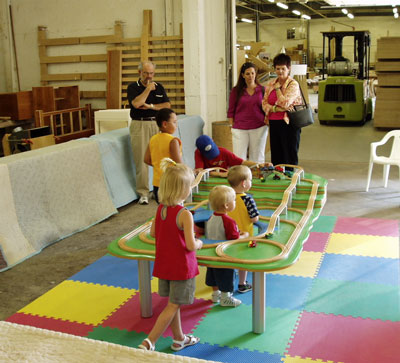
Vol. V, No. 4, November 2006 - January 2007
- Choosing toys of value: TRUCE Toy Action Guide
- What's a green business?
- Announcing a new Institute on Creating Children's Environments
- Creating eco-healthy childcare environments
- National program for playground safety announces classes
- Another option for safety surfacing under indoor climbers
- Check out playground safety issues in Alaska
- Developing children's play
- Report on greening America's schools: costs and benefits
- Looking for safer pest management control?
- What does it mean for your playground equipment manufacturer to be IPEMA certified?
- Ways to be energy conscious and save $$$
- Recent and Current Projects
Developing children's play
Designing play that is both safe and interesting to children is no walk in the park! Change the smallest detail in the design, and children can behave in unexpected ways. That's why our company prototypes and tests all play equipment.
Designing play for young children is much more difficult than most people
realize. Difficult, that is, if you want it to work for children and to
be safe for them, as well. Children change dramatically in their size, skills
and interests in just a few years. For example, a 3-year-old has a median
height of 37 inches (94 cm), whereas a 7-year-old's height is 48 inches
(122 cm). That presents serious challenges for designing play events and
equipment that will work for both ages.
We have to custom-design almost all of the play equipment for our children's
play and discovery centers and children's museums that we develop
for clients. We have learned that despite all the anthropometric data and
experience we have, observing children in play and other environments, children
can behave in unexpected ways with only the smallest change in the environment's
design. As a result, we prototype any new equipment design and test it with
children to make sure they exhibit the behavior the equipment is designed
to create.

Recently we designed a miniature train table for the edutainment dining room at our client's new Stone Fire Pizza Co. We created a prototype so we could test it with children. Well, we were surprised, but not shocked, when the theoretical table height that should work didn't. At the height the table was originally designed, younger children were climbing over the table to get into a hole in the center - instead of climbing under the table to access the hole, as we'd intended. We modified the table height by just two inches and the children behaved as planned. As they say, the devil is in the details.
Vol. V, No. 4, November 2006 - January 2007
- Choosing toys of value: TRUCE Toy Action Guide
- What's a green business?
- Announcing a new Institute on Creating Children's Environments
- Creating eco-healthy childcare environments
- National program for playground safety announces classes
- Another option for safety surfacing under indoor climbers
- Check out playground safety issues in Alaska
- Developing children's play
- Report on greening America's schools: costs and benefits
- Looking for safer pest management control?
- What does it mean for your playground equipment manufacturer to be IPEMA certified?
- Ways to be energy conscious and save $$$
- Recent and Current Projects

